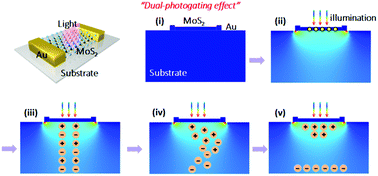A substrate-enhanced MoS2 photodetector through a dual-photogating effect†
Abstract
The high-performance, miniaturization and flexibility of two-dimensional (2D) material-based electronics and optoelectronics make them promising substitutes for silicon-based devices in the future. However, the complex structures and the assistance strategies needed to compensate for the intrinsic deficiencies of 2D materials are major challenges hindering practical applications. It is hoped to achieve high-performance 2D material-based devices of the simplest construction without external assistance. Therefore, making full use of the basic components (host material, substrate and electrode) of 2D devices is crucial. To date, the role of the substrate has always been ignored. Here, we choose undoped-silicon carbon (SiC) and Kapton (polyimide, PI) film as substrates for MoS2 photodetectors (PDs) for rigid and flexible applications, respectively. A new concept, the “dual-photogating effect” induced at the MoS2/substrate interface, is proposed and applied to obtain ultra-high photoresponse performance, such as high photoresponsivity of ∼104 A W−1 in MoS2/SiC PD and an on/off ratio of ∼105 in a MoS2/Kapton PD.



 Please wait while we load your content...
Please wait while we load your content...